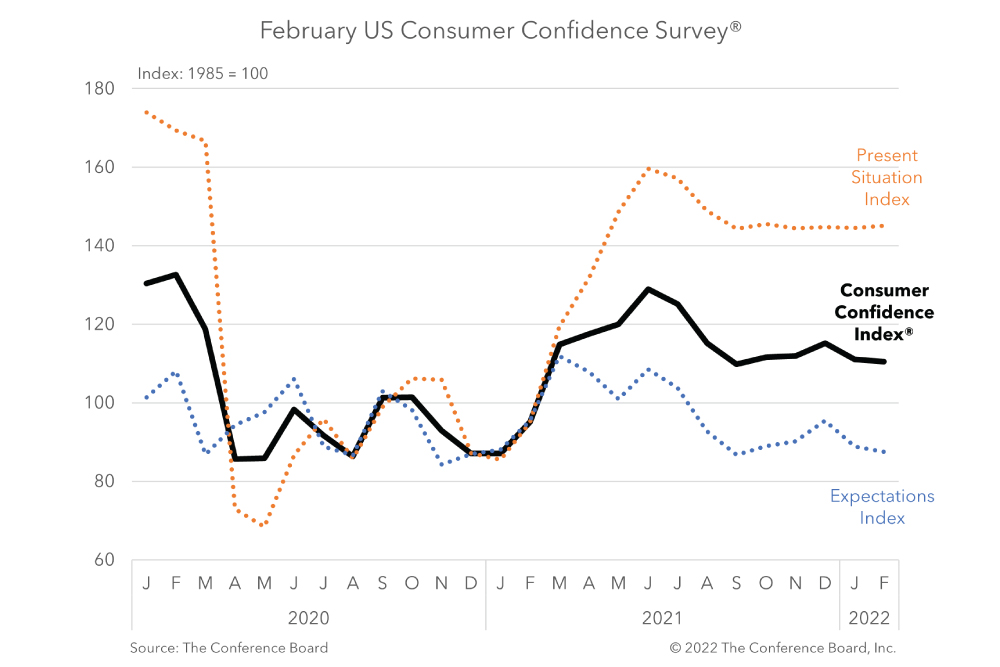ADVISORS MAGAZINE EXCLUSIVE - Assorted yield curves have inverted, which have historically signaled an end to good economic times. On March 31, the yield on 2-year Treasuries rose higher than that of the 10-year Treasury yields for the first time since 2019. But, the spread between the 10-year Treasury yields and the Federal Funds rate, a component of The Conference Board Leading Economic Index® (LEI) remains positive. And The Conference Board’s canary in the coal mine is still singing.
Risks to the global economic outlook from the war in Ukraine and tightening Fed policy notwithstanding, our leading economic indicators continue to point to positive growth in the US over the next six to nine months into early 2023. Importantly, the Leading Credit Index™, a broad measure of credit conditions and a subcomponent of the leading index, does not portend a US recession.
The LEI is rising moderately, which usually signals healthy growth. Experts have long used the LEI as a tool to anticipate whether a recession is looming. The US LEI’s 10 components combine to provide a summary of future economic conditions and risks. As a composite index calculated back to 1959, the LEI formed a peak and started a descent on average about 11 months before a recession began. In recent memory, the LEI turned down 11 months and 21 months ahead of the recessions that marked the end of the dot-com bubble (March 2001) and the great financial crisis (December 2007).
The LEI continues to suggest the US economy will grow in 2022. The Conference Board projects real GDP growth of 3 percent year-on-year and 1.7 percent 4q/4q in 2022. Labor markets are robust, and while consumers are jittery, they are not overly pessimistic. Housing construction is holding up as well as manufacturing activity. On the other hand, against a backdrop of robust economic activity and rapidly rising inflation, the Federal Reserve is raising interest rates.
We recently downgraded our 2022 and 2023 real GDP growth estimates. But we still anticipate the economy will expand above its long-term capacity to generate growth (approximately 1.7% per year) this year and next – an assumption supported by leading indicators in the near term. Nonetheless, risks still loom.
Take the Federal Reserve, for example. It is expected to raise its Federal Funds rate to close to 2 percent this year and to nearly 3 percent in 2023, as well as shrink the size of its balance sheet (which was expanding until recently to provide quantitative easing), as soon as May. Without Fed action, expectations of higher inflation could become self-fulling, imposing greater economic costs in the long run. The Fed’s action is appropriate. But if its efforts to tackle inflation are not well telegraphed and carefully calibrated, they could thrust the economy back into recession.
Likewise, the war in Ukraine has already created significant volatility in global commodity (energy, metals, and agricultural goods, for example) and financial markets. Prospects for a swift end to the conflict are receding, and new shocks related to the war, including embargos and shortages, remain a threat to global economic growth.
The LEI is not particularly good at capturing sudden shocks in real time. But its financial components, such as stock prices and the US Treasury yield spread, can provide some insights into the direction of the economy when shocks do happen. These signals can be especially useful if other leading indicators are also flashing red.
Still, what can help us see through the fog of sudden shocks or central bank overreach?
A subcomponent of the LEI is the Leading Credit Index™, which is a relatively new leading indicator of financial sector activity that can help spot recession signals in a timely fashion. It was added to the LEI in 2012 in the aftermath of the great financial crisis of 2008-2009. It is an indicator of business cycle peaks and troughs as measured by shifts in credit conditions to firms that make investments, which are typically a leading gauge of economic activity. (This contrasts with a financial conditions index, which measures instability or stress in general financial conditions.)
The LCI was designed specifically to provide early warning signs that something may be amiss, and that the change could be significant enough to signal a recession. As of March 2022, the LCI was firmly planted in expansionary territory, even while some other financial indicators (e.g., stock prices, some interest rate spreads) signaled trouble on the horizon.
Keep a close eye on the LCI going forward. It could signal whether the US is headed for a soft landing or another recession as interest rates rise and the stresses of the war in Ukraine reach US shores. If consumers pull back more than expected and/or businesses retreat on less favorable credit conditions, the LCI could be the canary in the coal mine -- particularly if the LEI and all of its other components also flash a downturn. So far, leading indicators point to slower, but continued positive growth ahead. Still, we should all remain vigilant.
Leading Economic Indicators Aren’t Signaling a Recession—At Least Not Yet



